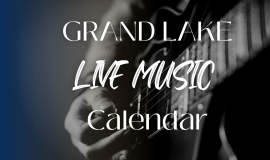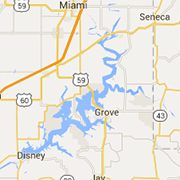GRDA Joins Forces with GLSPS for Life Jacket Programs
Following a dozen drowning deaths on GRDA waters last year, GRDA Police have committed to increase the use of life jackets on our lakes and rivers in an effort to decrease the number of deaths investigated. Not one person that died on our waters last year was wearing a life jacket, and there is little doubt the use of these life-saving devices will have a positive impact on the number of tragedies investigated by Police. For that reason, GRDA Police have increased their safety education initiatives, including partnering with members of the Grand Lake Sail & Power Squadron in an attempt to increase the use of life jackets through increased public education programs.
The partnership began at the 2017 Tulsa Boat, Sport and Travel Show when members of the GLSPS joined GRDA Police Officers at the GRDA Booth ineducating the public on how to properly select, fit and care for life jackets. A joint press conference was held with the Grand Lake Sail & Power Squadron during the event to talk about the value and necessity of wearing life jackets when on or in the water. At that press conference, GRDA also presented the GLSPS with a check for $5,200. Those funds will go to help the organization continue its efforts to educate the public about life jacket safety. The funds will be used to purchase life jackets that will be provided at no cost to the public at several events this year including the Grove Boat Show, the South Grand Lake Camp Bandage and to purchase life jackets for the static loaner stations the GLSPS maintains at several state parks on Grand Lake.
According to statistics from the United States Coast Guard Auxiliary, 76 percent of all boating fatality victims drown. And of those victims, a staggering 85 percent are not wearing life jackets. “In a boating accident, you can be thrown into the water unexpectedly,” said GRDA Chief of Law Enforcement/Lake Operations Brian Edwards, “and in those instances, there is no time to grab a life jacket. That’s why it is extremely important to already have it on.” Not only does wearing a life jacket dramatically increase survival chances in the water, but it also buys its wearer time. If you go into the water without a jacket, you will exert a lot of energy trying to stay afloat. By wearing a life jacket, you expend dramatically less energy as you wait for assistance. As part of the efforts to encourage life jacket usage, GRDA and the GLSPS are also educating the public on the different types of jackets available. Once upon a time, many people complained that life jackets were bulky, hot and restricted movement, all of which made them uncomfortable to wear. However, today, that is no longer an excuse. “These days, you can find a life jacket to fit just about any activity you have planned,” said Edwards. “They come in many styles, colors and are made of materials that make them much more comfortable to wear.”
To ensure that you have the right life jacket, GRDA offers the following tips:
- To help determine the right jacket for you, first check the label for rating type, intended use, size & weight and strength test. Also, the label should indicate if the jacket is approved by the United States Coast Guard.
- Buy your own jacket. ONE SIZE DOES NOT FIT ALL.
- If you are boating with children, make sure they are wearing properly fitted, child-sized life jackets based on their weight. Do not buy a life jacket for your child to “grow into.”
- Try it on to check the fit. Once the straps and buckles are secured, it should not slip over your head or come down above your ears.
- Never use water toys in place of an approved life jacket.
- Wear your life jacket to increase your chance of survival in an accident and to set a good example for others.
- Check your life jacket yearly for flotation and fit. Makes sure it is still in good condition, with no rips or tears.
Boating Tips from the GLSPS
The boats attitude affects its efficiency, steering and how it takes the waves which impacts comfort and speed. Raising the bow properly can increase speed by reducing the amount of hull in the water and decreasing drag. But if the water is choppy, getting the bow down will help the boat cut through waves providing a more comfortable ride with less “pounding” and better control. Each boat responds differently depending on its hull design, how it is loaded and the prevailing wind and water conditions. Proper trimming of the boat by adjusting the trim tabs if available, or carefully trimming the outboard or inboard/outboard drives is very important.
Interested in becoming more confident in your boating skills? The United States Power Squadrons offers many courses such as weather, seamanship, navigation, marine mechanics and marine electronics online and in the classroom. For more information visit our website at: www.grandlakeusps.com or on Face Book at GLSPS.








